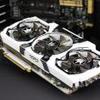Graphics card Thermal Imaging Temperature measurements
Thermal Imaging Temperature Measurements
A new addition to our reviews will be the inclusion of Forward Looking Infra Red thermal images of hardware. Over the past years we have been trying to figure out what the best possible way is to measure temperatures on hardware. Multiple options are available but the best thing to do is to visualize heat coming from the product or component being tested. The downside of thermal imaging hardware is simple, FLIR camera's with a bit of decent resolution costs up-to 10,000 EUR. Hence we passed on it for a long time. With a thermal imaging camera a special lens focuses the infrared light emitted by all of the objects in view. This focused light is scanned by a phased array of infrared-detector elements. The detector elements create a very detailed temperature pattern called a thermogram. It only takes about one-thirtieth of a second for the detector array to obtain the temperature information to make the thermogram. This information is obtained from several thousand points in the field of view of the detector array. The thermogram created by the detector elements is translated into electric impulses. The impulses are sent to a signal-processing unit, a circuit board with a dedicated chip that translates the information from the elements into data for the display. The signal-processing unit sends the information to the display, where it appears as various colors depending on the intensity of the infrared emission. The combination of all the impulses from all of the elements creates the image. We can seek hotspots on the PCB indicating, for example, GPU but also VRM temperature as well as how heat is distributed throughout a product. We do hope you will enjoy this new technology as it did cost us an arm and a leg to be able to implement it.
We reach roughly 70 degrees C on M3/M2, the GPU area. At M4 the VRM area is located, this as well is running roughly at 70 Degrees C. All looks good really.
When we position the thermal camera outwards we can see that the overall cooler design really works well. Take a good look, as that is what we like to see, lots of dimmed colors and nothing bright aside from the M4 hotspot, the VRM area. That equals to a modestly cold heat signature overall.
If you look at the cooling radiator you'll notice it stays well cooled and thus that indicated more than enough cooling performance. The rear exhaust exit is not lighting up though, indicative that heat mostly will be ventilated inside the chassis.
A top view thermal image shows no heat leakage into the motherboard, overall this can be considered to be very good thermal properties.




